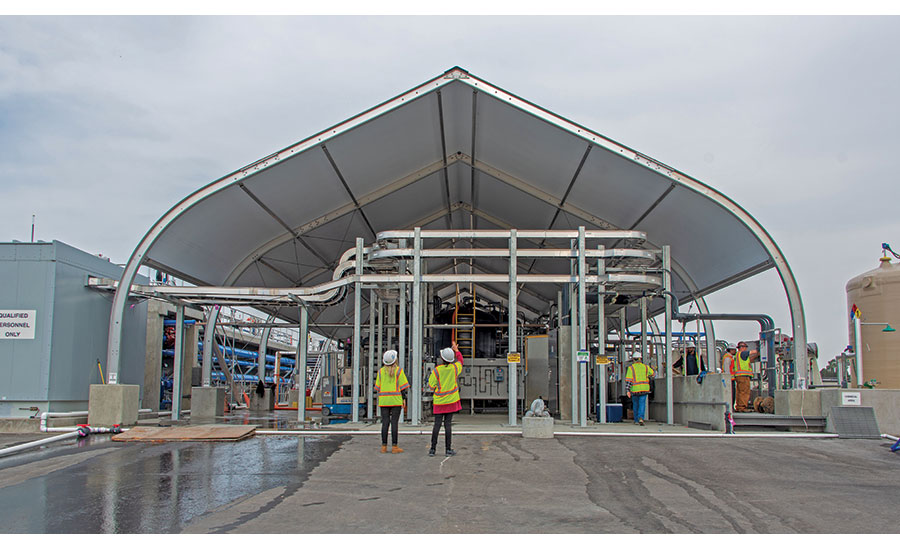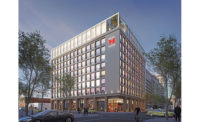Despite its reputation as a conservative owner, the Metropolitan Water District of Southern California (MWD) is piloting a bold new initiative to produce an additional regional water source through its Regional Recycled Water Program, which aims to take treated sanitation water and purify it to produce high-quality drinking water.
The program includes the use of an advanced water-purification system that would be the first of its kind in the U.S. In light of its efforts to meet Southern California’s need for an additional water source through innovation and efficiency, ENR California named Metropolitan Water District of Southern California its Owner of the Year for 2020.
The $3.4-billion plan could produce up to 150 million gallons of purified water daily, addressing the needs of more than 500,000 homes and industrial facilities. If successful, a full-scale plant could provide recycled water treated from the Carson, Calif., plant—water that is currently discharged into the ocean.
By treating the region’s largest untapped source of wastewater, the program aims to address Southern California’s critical need for a regional water supply. Southern California’s groundwater basins, which provide about 30% of the region’s water supply, have seen levels drop to historic lows in recent years. By replenishing those basins, the program could provide a drought-proof source of water to support the region’s future growth at a cost comparable to other local water resources.
Deven Upadhyay, COO and assistant general manager at MWD, says the Regional Recycled Water Program illustrates the water wholesaler’s interest in technical innovation while remaining measured and methodical in its approaches.
“Where we’re more conservative and not wanting to be on the bleeding edge of innovation would be things like water quality,” he says. “Our recycled water program is an innovative program, but we’re doing it in a very cautious way.”
MWD spent 10 years developing the program, launching the first pilot tests last year with the opening of the Regional Recycled Water Advanced Purification Center.
“Our recycled water program is an innovative program, but we’re doing it in a very cautious way.”
– Deven Upadhyay, COO and Assistant General Manager, MWD
The $17-million facility—which broke ground in 2017 and opened in October 2019—uses water from the Sanitation Districts of Los Angeles County’s Joint Water Pollution Control Plant in Carson and purifies it to produce high-quality drinking water.
The testing facility’s results will help determine whether MWD and the Sanitation Districts can develop a full-scale plant in the coming years. The new combination of treatment processes starts with membrane bioreactors, where microorganisms remove ammonia and other nitrogen compounds.
Next, using reverse osmosis, pressurized membranes further remove microscopic materials such as bacteria, pharmaceuticals and salts. Finally, ultraviolet light and a powerful oxidant destroy remaining viruses and trace chemical compounds.
The treated water is then added to four groundwater basins in Los Angeles and Orange counties for recharge and storage. Eventually, it is pumped and disinfected again before entering the water supply. While the technologies are not new, this particular process would be a first in the U.S., according to MWD.
Martha Tremblay, the Sanitation Districts’ project manager for the recycled water program, says the program offers an opportunity for two large agencies with significant internal resources to tackle a unique challenge.
Tremblay notes that each partner brings its own expertise. The Sanitation Districts, for example, has extensive experience in biological treatment, while the MWD labs tackle drinking water pathogens such as cryptosporidium and giardia.
“We have our strengths and they have their strengths, but we have common objectives,” Tremblay says.
With the treatment piloting underway, MWD aims to begin the environmental impact report process and preliminary engineering by year’s end, which John Bednarski, chief engineer at MWD, estimates could take 18 to 24 months to complete. Then, after WHO’s approval, the full-scale program, including associated distribution lines, would take about 11 years to design and construct, he says.
Over the years, Metropolitan’s focus shifted primarily from new growth to asset management as aging infrastructure begins to fail. Today, upgrades, refurbishment, replacement and other asset management needs represent about 80% of its annual capital improvement program. Currently, one of its largest rehabilitation efforts is on its Second Lower Feeder project, which relines pre-stressed concrete cylinder pipes from the 1960s with steel. The $575 million project began in October 2017 and is expected to be complete in 2026-27.
MWD’s wide-ranging asset needs create numerous opportunities for Southern California contractors. With an annual spend of around $250 million, Bednarski says MWD can have up to 350 projects going at any one time.
A large portion of work is handled in house by Metropolitan’s Engineering Services Group, led by Bednarski. With a staff of 355 employees, a third of the group is dedicated to project management, another third to design and the remainder are involved with construction management, surveying, safety and other disciplines.
Retaining so many in-house resources is an advantage. “Our in-house staff understands what our operations group needs and wants to have done,” Bednarski says. “Every owner has a certain way they like to run their facilities. We don’t have to go through a big wind-up with a consultant every time we [start a project]. We know what we want, and we can respond quickly.”
Steve Cox, vice president at J.F. Shea, which currently has four projects underway for MWD, says that Metropolitan’s in-house capabilities streamline project delivery.
“MWD knows what they want, and their specifications and plans reflect that,” he says. “In my opinion, they have the best plans and specifications out there. They are well standardized, and it’s easy to follow.”
In addition to working with large contractors like J.F. Shea, MWD’s internal goal is to have 25% participation by small, minority-owned, women-owned or veteran-owned businesses across its program. “We have a business outreach group that makes sure [small businesses] are aware of upcoming bidding opportunities,” he says, noting that MWD has met its small business targets for more than a decade.
MWD continues to use traditional design-bid-build delivery methods, which Bednarski says work well with its internal engineering group and provide a good value. Still, he says Metropolitan is not opposed to pursuing alternative-delivery methods in the future, but that would require enabling legislation at the state level.
“The recycled water program may provide an opportunity for design-build or another methodology,” he says. “We look at these things on a case-by-case basis.”


